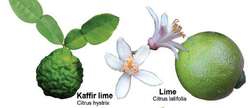lime
1lime
2lime
3lime
lime
[līm]lime
Lime
an arbitrary general term for the products of calcination and subsequent processing of limestone, chalk, and other carbonaceous rocks. The term is usually used for both unslaked lime, CaO, and the product of its reaction with water, slaked lime, Ca(OH)2. Lime is used extensively in construction, metallurgy, and the chemical industry; in the production of sugar, paper, and glass; in agriculture; and for water purification. Other forms of lime are soda lime and bleaching powder.
Building lime is a binder. It contains up to 95 percent CaO. It is produced by calcination of natural calcium and magnesium carbonates at 1100°-1300°C in shaft and rotary furnaces. Lime is one of the oldest binders. It was used in a mixture with sand and water as early as 3000–2500 B.C. to bind stones and bricks in various buildings, as well as for making plaster mortars and colored compounds. Under the action of carbon dioxide in the air, such a mixture gradually hardens through the formation of crystalline calcium carbonate and evaporation of water:
Ca(OH)2 + CO2 = CaCO3 + H2O
In modern construction, lime is used to make mortars and concretes, silica brick and artificial building stone, and blocks. Depending on its chemical composition, a distinction is made between air-hardening lime, which consists primarily of calcium and magnesium oxides, and hydraulic lime, which in addition contains a considerable quantity of silicon, aluminum, and iron oxides. Air-hardening lime makes possible the hardening of mortars and concretes and the retention of strength under air-dry conditions; hydraulic lime provides these properties in both air and water. In construction, a distinction is made between ball and powdered lime; the latter is divided into unslaked ground lime and hydrated lime (calcium hydroxide), which is produced by slaking (hydration) of calcium, magnesian, and dolomitic lime with a small amount of water. Treatment of unslaked lime with excess water gives lime paste. The most promising uses of lime are in the production of silica brick, autoclave silicate-concrete articles and structural members, and mixed lime-slag and lime-pozzolanic binders.
